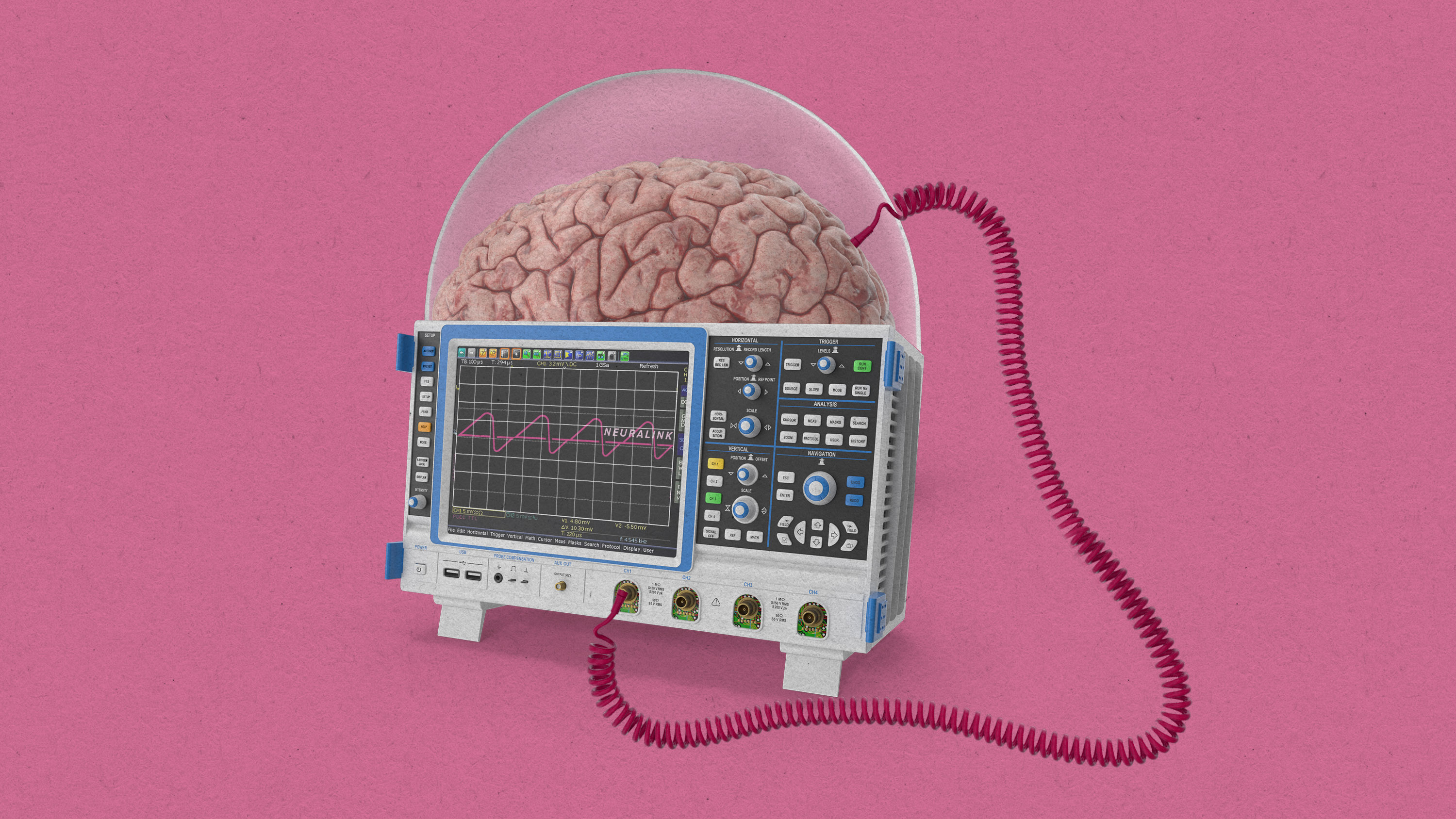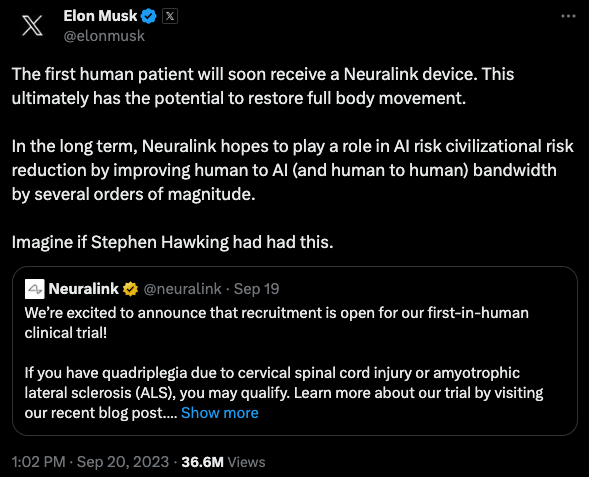Elon Musk wants more bandwidth between people and machines. Do we need it?
Speeding up communication between humans is surprisingly tricky.

This article first appeared in The Checkup, MIT Technology Review’s weekly biotech newsletter. To receive it in your inbox every Thursday, and read articles like this first, sign up here.
Last week, a post by Elon Musk on X (formerly known as Twitter) caught my eye. The entrepreneur claimed that sticking electrodes in people’s heads is going to lead to a huge increase in the rate of data transfer out of, and into, human brains.
The occasion of Musk’s post was the announcement by Neuralink, his brain-computer interface (BCI) company, that it was officially seeking the first volunteer to receive the “N1,” an implant comprising 1,024 electrodes able to listen in on brain neurons.
This volunteer, the company said, will be someone who has ALS or has been paralyzed due to a spinal cord injury. The point of the experiment is to let them “control external devices with their thoughts”—specifically, move a computer cursor, or control a phone app. There’s little doubt they can do it. Such experiments have been going on for decades.
One difference is that the N1 device has more than twice the number of electrodes as used in previous implant experiments. More electrodes means Neuralink can collect more data from more nerve cells.
That brings us to to Musk’s post, in which he discussed a long-term goal of vastly increasing “bandwidth” between people, or people and machines, by a factor of 1,000 or more. What did he mean, and, I wondered, is this really possible? Are we talking about some kind of fast telepathy where I could tell you about my day in nanoseconds?
Here’s what his X post said:

After speaking with a few scientists, I can report to you that the idea that a brain implant can speed up communication between, say, you and me, is largely hogwash. However, speeding up the rate at which machines can read from the brain is very real, and it is key to some cutting-edge uses of mind-reading interfaces, like allowing profoundly paralyzed people to “speak” via a computer.
“Bandwidth” in this case simply refers to a rate of data transfer. Scientists have estimated that humans share information at a speed of around 40 bits per second, no matter what language they use. That’s pretty slow. (A computer download is a million times faster). And there are reasons why it might never speed up. Ever have two people talk to you at the same time? Your ears let the information in, but your brain can’t process it. The speed of thinking itself sets a limit on your bandwidth.
“The idea that we’re going to hook up two people with bits of wire and do better than what you and I can do right now, speaking, is folly,” says Lee Miller, a neuroscientist at Northwestern University who works with brain interfaces. “If that’s the plan, I’m not investing.”
Yet scientists concede there are situations in which faster data transfer could allow a fundamental change in how we express ourselves. Say you’ve been mugged and you want to describe the face of your assailant to a sketch artist. Even though you can picture it clearly, it’s going to take a while for you to communicate those details at your spoken-word rate of 40 bits per second.
Yet, in theory, mental images could be communicated directly between minds. Researchers pointed me to the case of Krista and Tatiana Hogan, twins conjoined at the head who share part of their brains. It’s claimed they can see through one another’s eyes, in effect sharing information coming off the retina into the optic nerve at 10 million bits a second.
In fact, Neuralink has started investigating whether its implant electrodes can stimulate the visual cortex of monkeys. Vision produced in this way is extremely crude—essentially, just a few spots of light—but it could get better with more and more electrodes. One day, it might be possible to transmit a picture between two brains over a cable.
“Elon thinks a lot about mental imagery, and I believe he’s imagining a future where the image that I’m thinking of could be presented to you, or stimulated directly in your cortex,” says Vikash Gilja, a professor at the University of California, San Diego.
So that’s where more bandwidth could make a difference—not in speeding up speech, but in unexpected forms of thought transfer. It’s also possible, for example, to detect emotional states, like whether a person is depressed, by measuring the brain. Those feelings are not only hard to describe, but you might not even be aware of them.
“I think that there are going to be profoundly interesting things that BCI can read out that people can’t, let’s say, communicate volitionally very easily right now,” says Matt Angle, CEO of Paradromics, a Texas company which has developed its own implant system with around 1,600 electrodes. “Electrodes reading from different brain areas could give access to information that’s not ... consciously accessible.”
But let’s return to Earth and the near-term applications of brain-computer interfaces. Do they need more bandwidth? The main use of these devices is to let a paralyzed person operate a computer by moving a cursor with their thoughts. For that, more bandwidth isn’t really required. Scientists can do that by listening in on a few neurons, and adding more will typically bring diminishing returns.
Where collecting more information will be helpful—and where implants with more electrodes will help—is to unlock more natural communication. We saw some of those this year, including when two paralyzed people were able to speak through a computer, using their thoughts.
This works because when the subjects imagine saying words, the electrodes measure their motor neurons, whose firing rate contains information about how they are trying to move their tongue and larynx. From these data it is now possible to determine what words people are thinking of saying with surprising accuracy. Researchers believe that with more electrodes listening to more neurons, and more bandwidth, they’ll get even better at it.
“We don’t need more electrodes for cursor control, but for speech, we are in a regime where data rate matters a lot,” says Angle. “It’s very clear we need to increase the channel count to make those systems viable. With a thousand electrodes, it will be as good as a cell phone transcribing your speech. So in this situation, yes, you’re increasing the information rate by 10 or a hundred times.”
Bottom line: When it comes to enhancing communication between nondisabled people my sources were skeptical that more bandwidth matters. The brain’s going to get in the way. But when it comes to restoring function, it does matter. It takes a lot of neurons—and a lot of data—to get a patient back to communicating at that basic 40 bits a second.
Read more from Tech Review’s archive
In 2021, I profiled Dennis DeGray, a paralyzed man who, at that time, was the world record holder for direct brain-to-computer communication. He could type via his thoughts at 18 words a minute “It’s almost a conversation between the device and myself,” DeGray told me. “It’s a very personal interaction.”
But speed records keep falling. This August, researchers demonstrated that two people who’d lost the ability to speak–one due to a stroke, another because of ALS–were able to quickly utter words through a computer connected to implants placed in their brains. Read the report by Cassandra Willyard here.
A few years back, Adam Piore recounted the bizarre tale of Phil Kennedy, a pioneering brain-implant researcher who took the extreme step of getting an implant installed in his own brain.
From around the web
A second person has received a heart from a gene-modified pig. Lawrence Faucette, a Navy vet with heart failure, underwent transplant surgery on September 20 in Maryland. The previous subject lived two months after the surgery. (Associated Press)
Scientific sleuths are getting better at uncovering rotten research. (WSJ)
Those new generation weight-loss drugs were prescribed to 1.7% of Americans in 2023. And you can expect the market for semaglutide to expand fast. That’s because more than 40% of Americans are obese. (CNN)
Deep Dive
Biotechnology and health
How scientists traced a mysterious covid case back to six toilets
When wastewater surveillance turns into a hunt for a single infected individual, the ethics get tricky.
An AI-driven “factory of drugs” claims to have hit a big milestone
Insilico is part of a wave of companies betting on AI as the "next amazing revolution" in biology
The quest to legitimize longevity medicine
Longevity clinics offer a mix of services that largely cater to the wealthy. Now there’s a push to establish their work as a credible medical field.
There is a new most expensive drug in the world. Price tag: $4.25 million
But will the latest gene therapy suffer the curse of the costliest drug?
Stay connected
Get the latest updates from
MIT Technology Review
Discover special offers, top stories, upcoming events, and more.